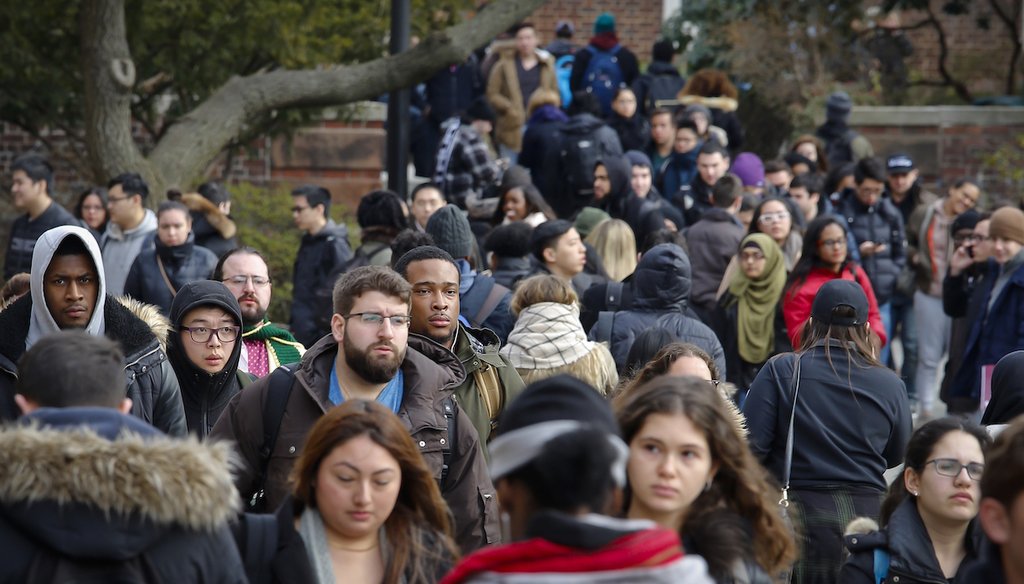Stand up for the facts!
Our only agenda is to publish the truth so you can be an informed participant in democracy.
We need your help.
I would like to contribute

Brooklyn College students walk between classes on campus in New York in 2017. (AP)
If Your Time is short
-
People who make under $75,000/year owe about half of $1.6 trillion in government student debt.
-
White borrowers owe about 60% of the total, Black borrowers about 24% and Hispanic borrowers 9%.
-
Limiting debt relief to people making below a certain income has a significant impact on targeting debt forgiveness.
Roughly 43 million American borrowers have a direct stake in what President Joe Biden decides to do about student loan debt. Plenty of Democrats are pressing him to grant at least some relief, particularly as a pandemic-driven repayment pause ends after August.
"We’ve got millions of people across this country who say they are not ready for their student loan payments to resume, that they simply can’t manage those loan burdens," said Sen. Elizabeth Warren, D-Mass., April 24 on CBS.
On the flip side, Republicans like Arkansas Sen. Tom Cotton have attacked the idea.
"Why should a trucker who didn’t go to college have to pay off a lawyer’s student loan debt?" Cotton tweeted April 26. "Because that is what Biden is proposing when he says he will ‘forgive’ student loan debt."
The thing is, we don’t know what Biden has planned. Whether canceling student debt skews toward the well-to-do depends on the rules that guide the relief. There are several ways to tie forgiveness to income, and right now, Biden has not tipped his hand, though he has dropped hints.
"I am not considering $50,000 debt reduction," Biden said April 27. "But I’m in the process of taking a hard look at whether or not there will be additional debt forgiveness, and I’ll have an answer on that in the next couple of weeks."
Republican opposition would likely block a debt relief bill in the Senate. That means any action would need to come through executive action. And it would focus on government, not private, loans.
Combined, Americans have borrowed $1.7 trillion. Nearly all of that, $1.6 trillion, is on the government’s books, and Washington has been counting on people paying it back. That includes direct loans issued by the federal government ($1.38 trillion) as well as other loans guaranteed by the federal government.
Slightly more than half of all borrower households (54%) make $75,000 or less — a bit higher than the median family income of $67,500. But this same group owes slightly less than half (45%) of the total number of dollars the government has lent. That’s in line with the general rule that education leads to higher pay. Someone with an undergraduate accounting degree might have lower debt, but they might not make as much as a software engineer who borrowed more to get a masters.
As part of the sweeping pandemic relief CARES Act, borrowers have not had to make any payments since March 2020. President Donald Trump extended it twice, and Biden four times. The latest extension ends Aug. 31, 2022.
Debt relief raises a host of questions of fairness and fiscal concerns. Any debt the government cancels adds to the deficit, with the repayment spread across all taxpayers. And as the country tries to tamp down inflation, not collecting money puts more cash into an overheated economy.
Critics, like Cotton, see borrowers as a lucky elite, and ask why everyone else should pay for the education they received. Supporters note that the high cost of higher education has meant that people of modest means have been forced to borrow more.
"Student debt cancellation does not benefit the rich because rich people overwhelmingly do not borrow to go to college," said sociologist Charlie Eaton at the University of California Merced.
Differences in household finances show up in the experiences of borrowers from different ethnic backgrounds.
For all college debt, the latest Federal Reserve Bank survey of consumer finances shows that about a third of Black people have an education loan and they have the highest average amount of debt — $30,000, compared to $23,000 for white borrowers, and $17,600 for Hispanic borrowers. There are many more white than Black borrowers, and a study from the Urban Institute, a Washington policy research group, found that white borrowers hold about 60% of government student debt. Black borrowers account for nearly 25%. Hispanic people borrowed about 9% of the total.
According to the Congressional Budget Office, nearly half of the debt is for graduate school programs.
Given that people making $96,000 or more hold about 40% of the government’s lending, Republicans have questioned the fairness of debt relief.
"Forgiving student debt is a massive windfall to the rich," tweeted Ohio Republican U.S. Senate candidate J.D. Vance.
While that could be so, there are ways to target debt forgiveness.
The federal government already has a limited loan forgiveness program, in addition to a separate approach that ties repayments to a person’s income.
Loan forgiveness is available for people with disabilities and for people who work full-time for a nonprofit or the government (federal, state, local or tribal). A borrower needs to meet a number of conditions, such as having a direct loan from the government and using the income-driven repayment option. So far, Washington has canceled over $14 billion in debt for about half a million people.
The income-driven repayment program has existed since 1995, but it didn’t get much use until after the Great Recession of 2009. Today, it includes about 9 million people. Under the program, payments are limited to 10% to 15% of what the government calculates is a person’s discretionary income. Any debt not repaid after 20 to 25 years is written off.
To go beyond either of those approaches, the administration is looking at broader debt relief. Many different scenarios are possible, but most options tinker with two factors: the amount of the relief, and an income cap on who qualifies.
Analysts at the Federal Reserve Bank of New York played out the consequences of using $10,000 and $50,000 in relief, and imposing no income cap or imposing a cap of $75,000.
They didn’t have borrowers’ incomes, race or ethnicity, but they did have their location, and with that, they filled in those values based on the income and racial and ethnic mix of their neighborhoods. What they found is that a combination of $10,000 in relief with a $75,000 income cap gave more than 80% of the benefits to people in neighborhoods where incomes were under $78,000 a year. That left about 17% going to people in neighborhoods where incomes were above $78,000.
In the match-up between the amount of the relief and using an income cap, the income cap was the key factor in targeting aid to the less affluent.
"Increasing the threshold from $10,000 to $50,000 results in a marginally larger share of forgiveness to high-income areas," the Federal Reserve Bank of New York analysts wrote. "Adding a $75,000 income cap for forgiveness eligibility significantly shifts the share of benefits."
They tackled the distribution by race and ethnicity the same way, this time comparing neighborhoods that are majority white to neighborhoods where Black or Hispanic people are in the majority. (The analysis didn’t get more specific than that, or deal with other ethnic groups.) Again, the income cap was the primary driver, delivering about 37% of the relief to minority neighborhoods, and about 62% to majority white areas. Without the cap, the difference wasn’t huge, but it tilted more toward white neighborhoods.
"The more you cut high earners out of receiving benefits, the more progressive the plan would become," said Beth Akers, senior fellow, American Enterprise Institute.
The question of who gains from debt relief is contested ground among policy analysts. According to his research, Eaton at the University of California Merced said even if some higher income people benefit, most of the help goes to middle and moderate income households.
Other studies, using other measures of debt, find that the well-to-do would do quite well, absent limits on relief.
Among the targeting options are methods that piggyback on existing means-tested government programs. The Urban Institute’s Matthew Chigas estimated that if relief went only to people who had used food stamps, welfare or a similar program in three of the past five years, 90% of the relief would go to the bottom three-fifths of income earners.
An alternative approach would offer relief only to people who had qualified for a Pell grant, a type of government school assistance based on "exceptional financial need."
It is unclear if Biden has the authority to give relief. Many Democrats believe that he does.
"President Obama did it, President Trump did it, and President Biden has now done it repeatedly," Warren said in her CBS interview.
That’s accurate, but those past actions were more limited than what’s on the table today.
During her run for president, Warren circulated a memo from the Legal Services Center of Harvard Law School. The memo argued that Congress had given the secretary of education "unrestricted authority to create and to cancel or modify debt owed under federal student loan programs in the Higher Education Act."
That take faced a challenge from an unexpected direction. Freedom to Prosper, a group that seeks to cancel all student debt, said that a president would need congressional approval. Without that, the group argued in a November 2020 memo, the administration would run afoul of the Antideficiency Act. Under that 1982 law, a president can’t spend money that Congress hasn’t appropriated, and they argue that not collecting hundreds of billions in debts would be a form of spending.
In the waning days of the Trump presidency, the top lawyer for the Education Department offered his legal opinion that the secretary could provide relief in small, limited ways, but not across the board. While the department had the flexibility to respond to emergencies like the COVID-19 pandemic, the Higher Education Act was very specific about the limits of that discretion.
The idea that broad and lasting loan forgiveness had been done before, he said, was wrong.
The department had never relied on any "statutory, regulatory, or interpretative authority for the blanket or mass cancellation, compromise, discharge, or forgiveness of student loan principal balances."
Our Sources
White House, Remarks by President Biden on the Request to Congress for Additional Funding to Support Ukraine, April 28, 2022
Federal Reserve Bank of St. Louis, Student Loans, April 7, 2022
U.S. Education Department, Federal Student Loan Portfolio, accessed April 29, 2022
Congressional Research Service, A Snapshot of Federal Student Loan Debt, Feb. 4, 2019
Congressional Budget Office, The Volume and Repayment of Federal Student Loans: 1995 to 2017, November 2020
Federal Reserve Bank of New York, Who Are the Federal Student Loan Borrowers and Who Benefits from Forgiveness?, April 21, 2022
Nerdwallet, Student Loan Debt Statistics: 2022, April 22, 2022
Brookings, Who owes the most in student loans: New data from the Fed, Oct. 9, 2020
Hutchins Center on Fiscal and Monetary Policy at Brookings, Student Loan Forgiveness Is Regressive Whether Measured by Income, Education, or Wealth, January 2022
Urban Institute, A More Targeted Approach to Student Loan Forgiveness, April 12, 2021
Roosevelt Institute, Student debt cancellation is progressive, June 2021
New York Times, Student Loans Are Set to Be Paused Again, Pushing Payments to September, April 5, 2022
Tom Cotton, Student debt tweet, April 26, 2022
Urban Institute, Can We Design Student Loan Forgiveness to Target Low-Income Families?, May 14, 2019
Government Accountability Office, Federal Student Loans: Supplemental Data on Income and Family Size Information for Income-Driven Repayment Plans, Sept. 29, 2020
Pew, Redesigned Income-Driven Repayment Plans Could Help Struggling Student Loan Borrowers, Feb. 8, 2022
National Association of Student Financial Aid Administrators, Issue Brief: Student Loan Repayment, May 2021
Inside Higher Education, Can Biden Cancel Student Debt? Depends Who You Ask, Aug. 11, 2021
New York Times, The Biden Student Debt Question: Will He or Won’t He?, April 26, 2022
Consumer Financial Protection Bureau, Borrower experiences on income-driven repayment, Nov. 22, 2019
University of Chicago Booth School of Business, INCOME-DRIVEN REPAYMENT PLANS FOR STUDENT LOANS, accessed May 2, 2022
Federal Reserve Bank of Philadelphia, Consumer Credit Explorer, accessed May 2, 2022
National Bureau of Economic Research, The Distributional Effects of Student Loan Forgiveness, April 2021
Legal Services Center of Harvard Law School, Memo on student debt cancellation, Jan. 13, 2020
Freedom to Prosper, Student debt cancellation backgrounder, November 2020
Office of the General Counsel — U.S. Education Department, Memorandum to Secretary Betsy DeVos, Jan. 12, 2021
Email exchange, Beth Akers, senior fellow, American Enterprise Institute, May 2, 2022
Email exchange, Matthew Chingos, senior fellow, Urban Institute, April 29, 2022
Email exchange, Charlie Eaton, assistant professor of sociology, University of California Merced, April 29, 2022
Email exchange, Sarah Sattelmeyer, higher-education project director, New America, April 28, 2022
Email exchange, Kevin Miller, associate director - higher education, Bipartisan Policy Center, May 5, 2022




















































